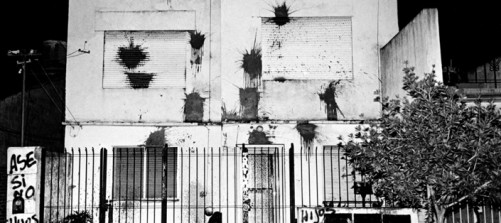A genealogy of affective politics
Visual practices of dissidence in post-dictatorial South America
What does it mean nowadays? Does it still have an up to date meaning? While living here we witnessed police repression in the Parque Centenario. The police completely emptied and blocked the park, by putting up fences during the night. The Parque Centenario, located in a strategic point in the heart of city, is the symbol of the people’s struggle during the crisis of 2001. Almost all the “asambleas barriales” (neighborhood self-organized assembly) were taking place here. Nowadays the park is hosting an organic vegetable garden and self-organized market stalls, just to name a few things that contributed to generate an ecological and alternative economy. On a micro-scale we were able to witness the formation of a neighborhood assembly in front of the park to defend their space despite the hot temperatures and the strong deployment of police.
It becomes clear, hearing people talking and discussing what to do, that they are experienced in self-organization, not only at the level of assembly planning but also in terms of structuring concrete political actions. Police does also have it, of course, and they have exploited the fact that there are summer holidays now, so most students are not here and popular resistance is much more limited then what it normally would be like.
But what is important here is that we witnessed something from close by: the penetration and absorption of affective policies into the social tissue just as if it were a chemical process.
Etcétera were part of this process-struggle during the Argentinean economical crisis of 2001. The practice of the “escrache”*7 *( 7 ) (kind of a collective and public denunciation of the military that benefits from amnesty. It consists of locating the person and make a public action were he/she lives) can be considered for the purpose of this article as the most significant example in order to analyze the affective bounds between visual practice and political activism.
Loreto emphasizes this struggle and how it finally led to the “juicios”. He also talks of the renewed continuation of these very practices today, giving the example of artists that are drawing the juicios because it is forbidden to film them. While Federico underlines the conceptual risk of tracing a linear genealogy from Tucumán Arde to the young collectives that were active during the crisis of 2001.
Of course the main risk of tracing a genealogy is falling into a banal linearity. On the contrary, what is interesting here is not only that different generations were active at the same time and collaborating with each other, but also how they started to articulate their own complexities and disagreements and how they fragmented (i.e. Madres de Plaza de Mayo are actually separated in two different associations with very different strategies regarding the construction of a memory as well as different political ambitions). In this sense an affective genealogy is made by several post-dictatorial micro-fictions. Therefore, it is not true to affirm that without Tucumán Arde or the Siluetazo, it would have been impossible for the young collectives that arose during the Argentinean crisis of 2001 (such as the GAC or Etcétera or Arde!Arte*8 *( 8 )) to continue their specific work with this kind of specific socio-political focus and with such public visual strategies. This would definitely be a very deterministic understanding that refuses to acknowledge that affective politics need a different time to sediment into a society and thus into visual practice.
It is an affective time, in which the present tense is only possible in a violent collision between past and future. This continuous movement produces a violent chronology of back and forth, between recall and oblivion. There are many ways of recalling and many ways of claiming for a sane right of forgetting that articulates a different subjectivity, an empowering one, rather than trying to erase history.
Giulia Cilla ( 2013): A genealogy of affective politics. Visual practices of dissidence in post-dictatorial South America. In: p/art/icipate – Kultur aktiv gestalten # 02 , https://www.p-art-icipate.net/a-genealogy-of-affective-politics/




 Artikel drucken
Artikel drucken